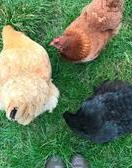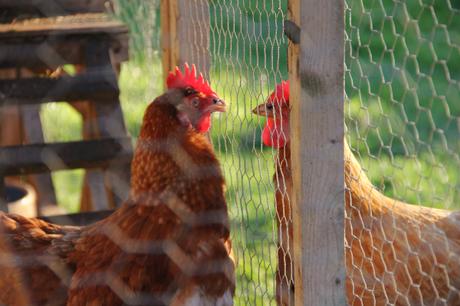
There’s no going back once you’ve caught the chicken keeping bug. Apart from the obvious reason why people decide to keep them, chickens are great company in the garden, fun to watch and seriously addictive. With so many breeds and pretty colours to choose from (don’t forget the many rescue hens needing homes too), it’s so tempting to bring home a couple more. However, adding new chickens to a flock isn’t easy, if it were I’d probably have way too many. If that’s even possible.
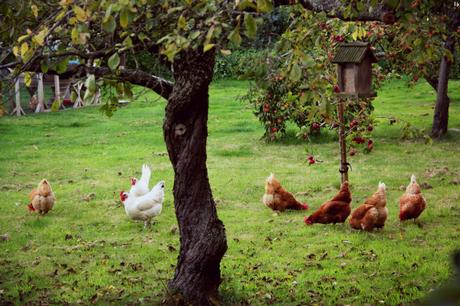
You see, chickens operate a strict hierarchy known as the ‘pecking order’, at least one hen will be in charge and she’ll be the most dominant hen in the flock. I call this position ‘top hen’. As lovely as chickens are they can appear to be cruel to each other at times and this behavior is clearly displayed when adding new birds to a flock. It can be upsetting for the chicken keeper to witness, but you must remember that it’s their language, they understand it and accept it. Some integrations are easier than others but this will depend on factors such as size of the flock you’re adding to, accommodation/space, time of year (winter integrations can be inconvenient for the chicken keeper), personality traits and broody hens can cause problems too. However, there are a few things you can do to help your new chickens settle in without too much stress and lower the risk of injury, read on to find out how.
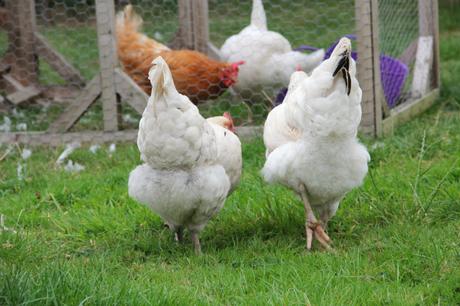
I don’t have a cockerel to help keep the peace within our garden smallholding flock, my years of experience with integrating and advice given here will be based on keeping a flock of hens only.
Behaviour to expect:
I study my chickens, I find their language fascinating, so I’d like to start by explaining the behavior you should expect to see from your flock when introducing new hens. The first thing I notice when introducing new hens into the garden smallholding is the racket our current flock makes, you may notice yours become noisier than usual for a few days at least. When integration gets underway, the top hen in your flock will exert her dominance immediately over the newbies, you may well find the current lower ranking hens in the pecking order suddenly become aggressive towards them too, and for the longest time. They will not want to be any lower in the ranks than they already are.
Neck feathers rise like dog hackles making the hen appear larger than she actually is, standing taller (as if on tippy toes) they barge each other with their chests, gaze locked in perfect concentration, kicking out with the feet aiming well-timed pecks towards the facial area until one hen gives in and retreats. This usually lasts for just a few minutes, it’s a quick scrap but horrid to see. Once this stage is complete the winners will chase the losers, jumping onto their backs, pulling at the comb and generally aiming hard pecks at the head (sometimes pulling feathers out).

Chickens are territorial so expect food and water to be guarded as well as the hen-house, you may have to physically put the new hens inside the hen-house at night if they chose to roost on top of it or elsewhere, if you do have to do this try to wait until it’s dark to prevent fighting breaking out inside the hen-house.
Expect chasing and guarding to continue for at least 3 weeks, then it should start to settle down with just the occasional bit of chasing. Eventually the pecking order will be established but the dominant hens of the flock will continue to give a reminder of their status every so often (don’t be surprised if this includes reminding the current members of the flock), should the other hens forget their authority over them. This is usually done by a little chasing, pulling combs and tail feathers or the ‘stare’ across a food bowl, resulting in the lower ranking hens breaking eye contact immediately and moving elsewhere (sometimes this is enough to warrant respect without any further action needed). Usually all of the current flock members triumph over the newbies for higher ranking within the new pecking order, but expect the odd surprise.
Bedtime always brings drama when integrating new chickens, expect noise and chasing. It will calm as the light fades. The dominant hens often guard the coop entrance to prevent the new additions from entering, the lowest ranking hen usually takes her position within the safety of the hen-house last and most probably later than she’d like, so do check around the garden with a torch before locking up at night if your hens are completely free-range.
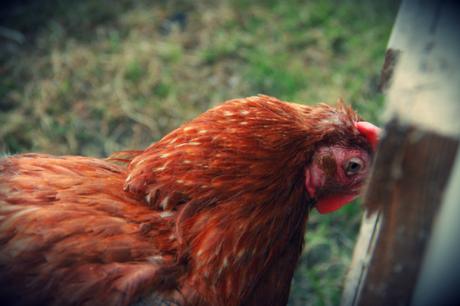
Tips to help the integration go more smoothly:
- After a period of quarantine, keep your healthy new additions separate from your current flock using chicken wire or netting as a barrier for about a week or so before fully introducing them to the flock, chickens recognize faces and it will make things a little easier in the long run. A temporary hen-house and run within the garden also works well (this is what I use). Your flock will be inquisitive about the new hens, so expect fighting through/against the wire/netting during this time, just keep an eye out for injuries.
- When you finally make the decision to mix the hens together without a barrier, add the new hens to the hen-house used by your chickens at night, after the flock have gone inside to roost, darkness brings calm and it’s unlikely any fighting will occur during the night. Be prepared to open up the hen-house earlier than usual each morning until the pecking order is established.
- Smear Vaseline on the combs and wattles to prevent a firm grip being had, you may need to reapply often but it really does help.
- Allow plenty of space, I can’t stress this enough. The more space you allow the easier the integration will be on the new additions. If you usually keep your flock in a run for a good part of the day allow the hens to free range the garden together for as long as possible, this really does help to minimise the fighting.
- Supervise free ranging during the early days of integration and use food such as mixed corn or mealworms as a distraction if bullying becomes a real problem.
- Place extra food bowls and water containers around to make food guarding harder, hang cabbages/greens as a distraction. Check the new additions are eating by feeling the crop during late afternoon. If you find there’s a problem, give the newbies some time out from the others, a quiet spot with some food and water and allow them time to indulge.
- Avoid adding a lone hen to an established flock, she’ll be the only target and this isn’t fair.
- Intervene if blood is drawn, check injuries and use purple or blue spray to disguise blood or redness on minor wounds to prevent further pecking or worse, cannibalism. For more severe injuries separate an injured hen from the flock for a few days to allow her time to heal and recover, but within sight of the flock.
- If you’re currently integrating chickens for the first time you may be feeling a little deflated if bullying within the flock is a problem. Follow my tips and try to remember it will get better in time. I’d always recommend keeping a watchful eye on integration proceedings until you’re confident the flock dynamics are going in the right direction.
With thanks to YouTube user Ann for permission to use this video
Filed under: Chicken Behaviour Tagged: chicken behaviour, chickens fighting, hens fighting, how to integrate chickens, how to integrate new chickens, integrating chickens, integrating hens, introducing chickens, introducing new chickens, new hens fighting, pecking order
